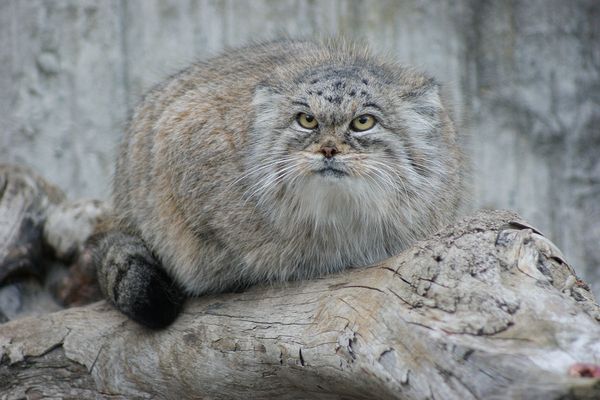Pallas’s Cat (Manul)

Content:
The cat was one of the first animals tamed by humans. Archaeologists found the skeleton of a domestic cat in the ruins of Jericho, one of the oldest cities in history. However, not all cats are tamed by humans. The wild Pallas’s cat, (also known as the manul), named after the German naturalist Peter Palas, is one of them. Peter Palas discovered and described this animal in detail in his notes. Today’s article is about this unusual wild and big cat.
Description, Structure, Characteristics
What does a Pallas’s cat look like? This cat is very similar to an ordinary domestic cat. Yet Pallas’s cat is many times larger and fluffier. Unlike a domestic cat, a Pallas’s cat cannot live in captivity at all. The body length of the Pallas’s cat is 50-65 cm. The average weight is 5 kg.
Pallas’s cat has the thickest wool among all the representatives of the cat family. The length of its hair reaches 7 cm.

Pallas’s cat’s head is slightly flattened; the ears are small and wide set. A similar structure of the head gives scientists reason to assume that the Pallas’s cat is a distant relative of the Persian cat.
The expressive eyes of the Pallas’s cat are yellow. Unlike a domestic cat, the pupils of this cat do not constrict in bright light but always remain round.

As for the color of the Pallas’s cat, usually the color of its coat is combined and is represented by a color scheme of light gray and yellow-brown colors. At the same time, the tips of its wool are painted white, and it seems that the manul is lightly powdered with snow.
Pallas’s cat has sharp claws and teeth like any decent cat.
Pallas’s cat was discovered only in the 18th century by the German naturalist Peter Palas, who conducted research on the coast of the Caspian Sea. Due to the efforts of Peter Palas, this wild cat became known to the general public.

Lifespan
How long does Pallas’s cat live? The life expectancy of Pallas’s cats is slightly less than domestic cats, which is not surprising because they live exclusively in the wild. Pallas’s cats live 10-12 years on average.
Habitats
Where does Pallas’s cat live? Pallas’s cats live in Central Asia; they are also found in Eastern Europe. Pallas’s cats can be found in Uzbekistan, Tajikistan, Iran, Pakistan, and Afghanistan.

As habitats, Pallas’s cats prefer the steppe area with stunted grass and shrubs. They also like semi-arid climate.
Lifestyle
Pallas’s cats lead a sedentary and solitary lifestyle. These are territorial animals. Each cat has its own “possession”, the boundaries of which are marked with urine. If another cat violates its territory, a fight is rather possible. Yet in general, Pallas’s cats are peaceful animals despite their stern appearance.
Pallas’s cats usually sleep during the day, as well as at night, hiding in a secluded shelter under stones or in old burrows of other animals (usually marmots, foxes, or badgers). These cats are crepuscular animals since they have hunting time in the evening and in the morning.
Diet
Pallas’s cats are real carnivores like all representatives of the cat family. The usual foods of these animals are various field rodents, ground squirrels, marmots, hares, and small birds.

Being the most clumsy and slow among the felines, the Pallas’s cats, however, have excellent vision, hearing, and sense of smell, which are actively used during the hunt. Pallas’s cats catch their prey by cunning; they usually guard it in ambush, hiding near the stones. The color of the cat serves as a kind of camouflage for him and allows him to go unnoticed. After a potential victim has appeared on the horizon, the manul makes a sharp jerk and grabs the “lunch” with its sharp claws. If the mouse or gopher managed to escape, then the cat will not continue to pursue its prey, since they do not run very fast. It is easier for them to watch for new “food” in an ambush again.
Enemies
Pallas’s cats have practically no enemies under natural conditions. Only packs of wolves and large birds pose a certain danger. Manuls will rarely fight, preferring to flee in case of danger and hide in a secluded place. An exception may be the moment when the manul was taken by surprise and driven into a dead end. Then he will begin to growl menacingly and bare his sharp teeth.

Character and Behavior
Pallas’s cat is an extremely cautious animal. Rushing somewhere headlong – this is not about him. In general, Pallas’s cats are very phlegmatic creatures, being active only in the morning and evening (the time of their hunting), the rest of the time they will be lethargic and inactive.
Pallas’s cat is a kind of hermit, it does not like the company of its own kind, and even more so the company of humans. Such a gloomy hermit character became the reason for failures in attempts to tame this cat. We will talk about the possible maintenance of Pallas’s cat at home below.

Species
There are 3 types of Pallas’s cat’s species and further we will describe them in more detail.
Pallas’s Cat Ordinary
Also known as a Siberian manul. It lives on the territory of the Russian Federation – in Siberia, in the Krasnoyarsk, the Altai Republic, in Transbaikalia, and Tuva. It can also be found in Mongolia and China. It has a predominantly light gray color.

Pallas’s Cat Central Asian
These Pallas’s cats live in a number of Asian countries: Uzbekistan, Iran, Turkmenistan, and Afghanistan. It differs from the Siberian manul in its reddish-brown color.

Pallas’s Cat Tibetan
Pallas’s cat Tibetan has darker fur, which in winter takes on a characteristic silvery hue. These cats live in the mountains of Nepal and Tibet.

Reproduction
The only reason why these hermit cats do get together is for reproduction. Their mating season begins in late February – early March, at which time the males begin to look for a mate for mating.
It’s funny that just before “this business” itself, males can gallantly look after their tailed “lady” – throw edible gifts at her paws and ferociously drive away other potential competitors. However, courtship does not last long, because of the short estrus in females, males need to have time to conceive children for several days, if this does not happen, then pregnancy this year can no longer be expected.
Having done the job, the males leave, leaving all worries about future kittens to the females. Pregnancy in a cat lasts 60 days, towards the end of this period, she is looking for a secluded place where blind and helpless kittens are born. From 2 to 6 kittens are born at a time.

Manul kittens at birth weigh only 200-300 grams. They are completely helpless and are under the full care of their mother. Mom takes care of her babies, feeds them with her breast milk, and teaches them to walk, hide, and then hunt. By the way, kittens go out for their first hunt by the age of 3 months, and by the 10th month of life, they become sexually mature adult cats, after which they leave their mother.

Keeping at Home
Despite the fact that the Pallas’s cat is extremely poorly tamed, there are exotic lovers who still risk getting a homemade Pallas’s cat. At home, the manul will behave wildly and unpredictably, it can easily scratch or bite when trying to stroke. You should definitely be prepared for scratched furniture and torn wallpaper if you want to have such an unusual pet.
Besides this, Pallas’s cats often begin to get sick in captivity, as if their very nature protests and demands a return to their native and wild habitat. Therefore, it is highly not recommended to keep Pallas’s cat at home.
Interesting Facts
- At the moment, the Pallas’s cat is listed in the Red Book as an endangered species being on the verge of extinction.
- Pallas’s cats are dedicated to a series of Tajik postage stamps, issued in 1996 under the sign of the Wildlife Conservation Fund.

